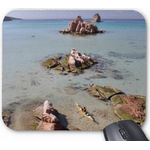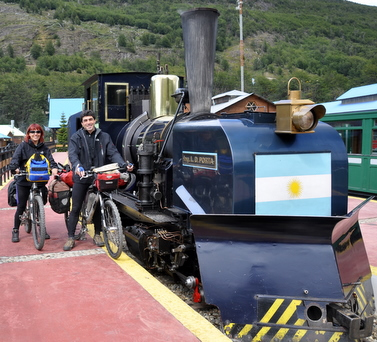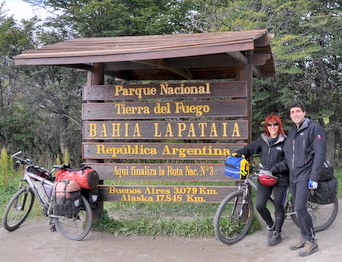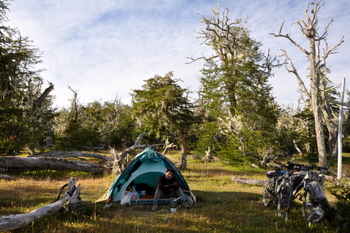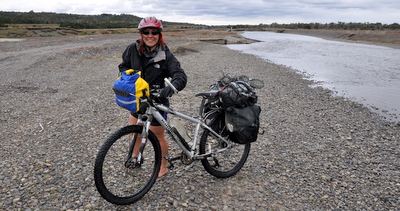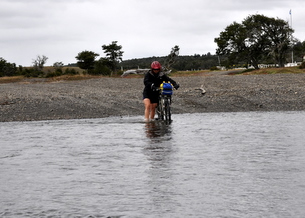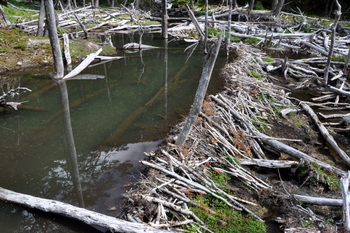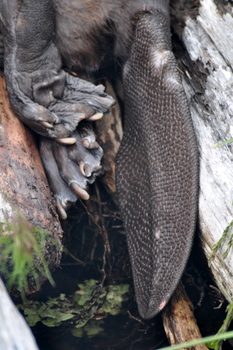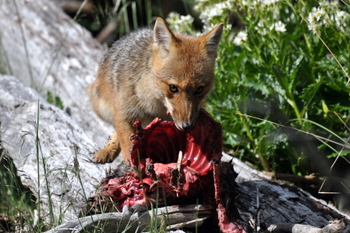• Logbook
• Road Stars
Photo album:
• Tierra del Fuego
Download Tierra del Fuego files:
• GPS track & waypoints
Lodging & eating:
• Panadería La Unión
• Lodge Deseado
• Imago Mundi Hostel
January 26, 2011: Fleeting visit to Tierra del Fuego National Park

The RN3 road begins Buenos Aires and ends in the Park. The road ends exactly at the Lapataia Bay; Alaska is only 17.848 Km away… After the mandatory photo, we decide that the hikes in the Park are not worth (compared to the ones we already enjoyed) and we return to Ushuaia to leave for the North one day earlier. The terrain is flat, so the 25 Km to Ushuaia pass quickly and here we are at La Posada del Michay to spend the night. Silvia is on the porch when we show up and she cannot believe her eyes. She threatens us to follow us to Rio Grande to make sure that we leave Ushuaia once and for all ;-)
January 27, 2011: Going North. Ushuaia to Lake Fagnano


January 28, 2011: From Lake Fagnano to La Union bakery
The day dawns sunny although the breeze is icy. The can of anchovies we are carrying is half empty and has lost some oil. Why oil always leaks? The salty anchovy sandwich is a little rough, but tomatoes weigh too much and get smashed easily. After some adjustments in the panniers and sewing the broken Velcro of my bike's triangle, we leave to rejoin the RN3. The journey becomes much more smoothly than yesterday. Is it because of the anchovies or because we are still fresh? Back to the RN3, the route runs with gentle undulations between forests and pastures. On the road we meet a couple of riders from Colombia. They left their country a year ago. Tomorrow they will surely arrive to Ushuaia, but they don't stop there. They'll go by bus to Buenos Aires and from there continue towards Uruguay and Paraguay.
The arrival in Tolhuin, today's destination, is preceded by a long climb. It begins to rain with enough intensity to stop and put the Gore-Tex on. Obviously, within a couple of minutes the sun shines again; to not sweat too much, we stop again to take it off. This seems to be a constant of the trip.


January 29, 2011: From La Union bakery to Lake Yehuin

Breakfast at the bakery is significantly more restrained than yesterday. We thank Emilio and start our ride through estancias territory. At the first junction of the RN3, we turn left to move away from cities and get in the rural area of estancias. You may be already aware but, when go north, turning left means going westward and in Patagonia this is of crucial importance, especially if you are travelling by bicycle. The prevailing winds come from the West!!! In fact, in no time it's already blowing. If you have never been to Patagonia, it is difficult to describe what this means, but here, wind is WIND.
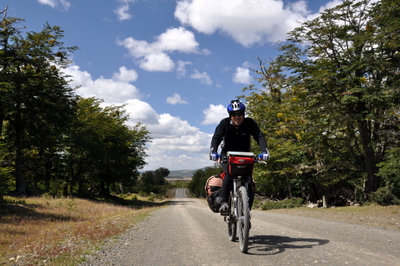
If fighting the fierce wind wasn't enough, its constant howling gets us on our nerves. As a remedy use the bandana Rambo style, but covering our ears to at least muffle the noise. The landscape varies between forest of lengas, steppe grass dancing with the wind and trunks still standing full of lichens hanging. The dirt road (ripio for the Patagones) undulates gently ascending low hills and descending to cross rivers and streams. Fortunately, the condition of the road is good and we always find some line to ride free of rocks.
Our destination for today is Lake Yehuin. When we arrive, we found the estancia not only abandoned but almost in ruins. However, the worst thing is the gang of weekenders with the car blaring radio. We have run out of water and are too tired to keep riding so that we continue along the shore of the Lake in search of a shelter from the wind and disco. We put our tent near a destroyed pier a few meters from the water. We take advantage of the sun to wash ourselves in the lake and do the laundry. While Judit reads about our next destination, I try for the second day the art of the trout fishing. I can confirm that there are no trouts in this lake. After losing a lure, catching a branch and making various knots in the line with my ability to launch, I give up and accept the leftovers of yesterday's salad. The sun is still warm when not behind the clouds. We prepare dinner and just spend a wonderful afternoon on the grass.
January 30, 2011: from Lake Yehuin to estancia José Menéndez
Today is Sunday… unfortunately for us. Today is the day of return for the weekenders who have spent the day or the weekend camping; the majority are from Río Grande and some from Tolhuin. This would be ok if it wasn't for the large number of vehicles that pass us full speed on this dirt road and if it wasn't because the large majority has no sense of respect for nature, in particular with regards to not polluting the environment.

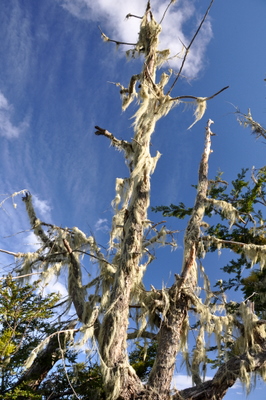
We reach the RN3, and undertake a hard fight against the front wind makes it even more difficult the uphill road. It is Sunday 7:00 PM and it seems to be the hour for the weekenders to return to Río Grande. The cars pass us too close, especially considering the difficulty in maintaining a straight path in our fight against the wind. The 5 km till the route B junction take forever. Luckily Cèsar is in front. Once on the dirt road, the wind is a small problem (even without having lowered its intensity). We can see the estancia José Menéndez, our destination for today and one of the biggest and oldest in this area. We ask permission for camping on private property, and the administrator, David, offers us to sleep in the barn. This is great, we will sleep protected from the wind. The barn metal sheet walls beat to the wind gusts but we are safe. David offers water and bread. Just what we needed! Thank you David!
January 31, 2011: From estancia José Menéndez to Puesto Laboratorio
Today we wake up at 6:00, a couple of hours earlier than usual. We want to test whether the wind has less intensity early in the morning. But the truth is that the barn walls are already complaining about the wind. It seems that the theory is not valid and as we are tired because of the 75 Km we rode yesterday, we stay half an hour more in the sleeping bag. To start the day, I go to the workers' kitchen to ask for water. In a brief conversation with one of the guys he tells me that today is the last day of the shearing season. When we cross the fence on our way out, we see them gathering the latest shaggy sheep.
The wind attacks us right from the start. Today we are riding almost perfectly West, exactly from where it blows. This area is far from the Darwin range and the only existing vegetation are low grass that does not serve as shelter. The ideal riding position would be crouched with your head low on the handlebars, but the arms cannot hold that position for long. It would be like make a push-up and stop half way indefinitely. So to reduce the exposed surface we contract our neck, tuck the elbows to the body and above all ride one closely behind the other. I realize I have an expression of stubbornness in my eyebrows against the wind, but for sure, sooner or later, I'll give up. Even he birds crouch when they stop. In fact, some walk rather than fly.
After some time we meet a group of boys riding horses in the direction of the estancia. Later, we find out its mission today was distributing the sheep shorn throughout the immense field of the estancia. In spite of most of the time having our heads low without looking too far, from time to time you have to look up. Often it's only to see the long road to cover or the next hill to climb. However, in one of the occasions I see a lost sheep in the middle of the road. As we approach it gets nervous and runs from one side of the road to the other. I guess it wants to jump the fence and go back to its comforting captivity with the rest of the herd, but it doesn't dare to cross any of the two fences. As we get closer, it gets scared and runs away from us forward. During some kilometers it seems we chase it. He runs away and stops to look back; waits for us and begins to run again when we get too close.
Today we stop more frequently than usual. We know the average speed will be considerably lower than other days. We set short-term goals to rest as a crossroads, a bridge or the next estancia. We get to the estancia Cauchicol where 3 workers repair a fence. They are drinking mate during a break. Of course they invite us to sip from the shared metal straw. We chat about our journey and their tasks for a while. With this slow progress, we are not sure how many days it will take us to get to Cameron (the next village), so we ask them if they have some extra bread. They give us a quarter of the homemade bread they brought the estancia. They set to work and we take cover in a kind of garage to devour the bread they gave us at the estancia Menéndez with a kind of jamón we bought in Ushuaia, soft, but it tastes delicious.
The terrain does not change; not a single tree or shrub where to take shelter, even temporarily. The pampa extends till the horizon. With our heads low, we don't see much; only the flowers and herbs that grow in the margins of the road. They shake violently at the mercy of the wind gusts. Our next rest is under the bridge of river Ona. It is an oasis of silence and peace compared with what is happening up on the road.
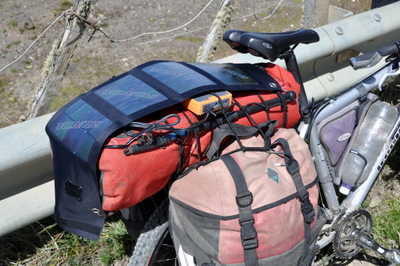
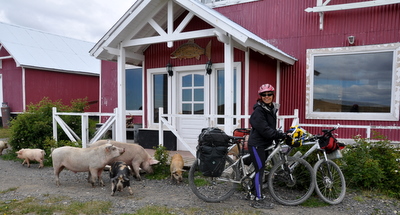
February 1, 2011: Changing plans – From Puesto Laboratorio to Lago Deseado
Today the wind blows with less intensity, but still cold. The first objective is to cross the border through the temporarily enabled checkpoints: Radman (Argentina) - Bellavista (Chile). Shortly after we begin the route we get to Puesto Laboratorio; it consists of a large house, which seems uninhabited; It's mission was to be a research center for the crops and cattle but it never came a reality. The next estancia on the road is San José. We ask for shelter to have breakfast and Victor indicates Radman is just one kilometer ahead (we already knew) and there's no one to meet us in house. He is lying... anyway... We reach Radman, stamps our passports, and now yes, we get some hot water from the gendarmes and we take our breakfast. We share our coffee with the border police. When we are almost done, we see a couple of cyclists across the river we have to cross to get to the Chilean post.
The river has no bridge and we know we have to ford it pushing our bikes. The police had indicated that the width of the River was 20 meters and height would reach our most sensitive parts.... They were kidding. In fact, the river is less than 10 meters and just goes over the knee.
The couple is formed by a Spanish and a Kiwi. They plan to get to Río Grande today, not a problem with tailwind. They convince us to visit the Lago Deseado (a recommendation made by everyone we have found. The lake is in fact on the road Yendegaia-Vicuña, that we had to discard because the road is still under construction farther South. Our doubts vanish when they offer us some tortillas, enough to meet our needs of bread, at least for another day.
The Chilean post consists of 4 or 5 houses in line. From the first, which reads a sign indicating the Information Office, two children come out and lead us to another house, in which his dad stamps our entry into Chile. Now we are officially in Chile! The terrain is still a dirt road, but in better conditions than the Argentinian one, which allows us to relax and speed up. There are more trees, not many but enough to mitigate the wind. We pass by a estancia before the turn off at Pampa Guanaco. We turn left, direction to Lago Deseado. The road undulates among woods, interrupted from time to time by open steppe. We are pedaling at good pace, but we have 60 kilometers ahead of us, on top of the 25 we have already ridden… The excesses of the last days (long kilometers against wind) are beginning to show up on Cèsar´s knee. To balance the effort I decided to take some of his weight, and so we keep riding to almost the beginning of the final mountain pass. That´s when my knee also starts to complain and the pain increases with every movement of rotation.
The landscape is far more beautiful than what we have seen so far: there are still sections of steppe where we can see countless herds of guanacos that approach us to check us out; we also see a group of 4 wild horses including a young one galloping by its magnificent mom.
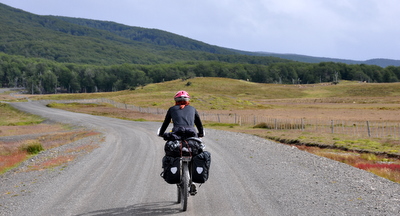
There we meet Don Ricardo, Fermín and Jorge. They immediately invite us to enter the office and offer hot coffee and homemade bread with figs marmalade (delicious!). We feel like in heaven. Especially for me, since I was frozen after the downhill and discouraged by the constant struggle with my knee pain which seemed to get worse with every meter. We are very grateful for their hospitality. After chatting with them for a few hours we go to put our tent in the area they authorized. After that, we return to Fermín (the personnel cook) and Jorge´s (the cabin builder) cabin to prepare our dinner.
We have decided to stay at least one day to see if the knee pain goes away before returning and tackling the climb we just descended. The place is awesome: a lake surrounded by high mountains of lenga and coigüe forest with only 6 secluded cabins. The cabins are exquisite: located on the shores of the lake, made of lenga wood with large windows facing the lake. They are very cozy, combining the charm of the wood and a wood fire, with the modernity of a central heating and design bathrooms. If we didn't have a budget constraint, it would have been a pleasure to spend the night in one of them… we would have to wait for another occasion. For the moment, we go back to our tent, also on the shore and with beautiful views to the lake.
February 2, 2011: A well-deserved rest in the Lago Deseado
Today we stay! The sun rises radiant, but soon the clouds show up. Then the sun fights back and it ends up in a sunny, perfect day for our well-deserved rest day. The knee still complains and I fear this is the beginning of a tendonitis due to the excess… It would be better to rest and not pedal for a few days.
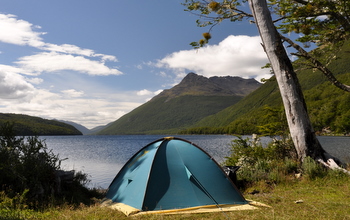
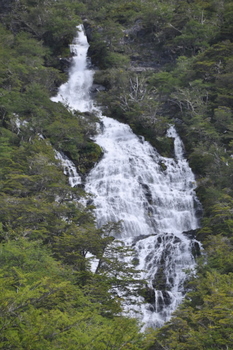
We descend to a flat area in which beavers have made their home. Their dams and channels are spectacular. It´s a pity no one has managed to train these animals for other works less destructive to the environment. The landscape they leave behind in pretty sad (fallen trees after being chewed, others already dried-up and others languishing in the lake formed by the dam). Locals don't appreciate them with reason. Looking at their constructions, we don't realize that a red fox is watching us. After checking we are not dangerous, it decides to return to its work. And to our surprise we discover that the Fox was busy tearing apart pieces of a dead beaver, trapped between trunks! The beaver seems bigger than the fox (judging by the size of the tail and its hind legs and long nails). Regardless of the desperate attempts by the fox to take the beaver out it has to give up… it seems too heavy; so it keeps tearing apart pieces of meat. Tired by the effort or our close company it leaves the castorera and its delicacy.
After enjoying the wild spectacle in the front row (about 10 meters), we resume our way down, this time on true right side of the creek. From here we have excellent views of the waterfall and the trail is drier and less tangled (after a few trunks). When we return, Cèsar and Fermín go fishing on the opposite side of the lake. I stay reading in the tent, sheltered from the cold that begins to be noticeable.
I have to admit that I have little hope about having trout for dinner… but I´m wrong! Cèsar manages to catch his first trout (a fighting silver) with the telescopic fishing pole we bought in Ushuaia :) Fermín takes it to his cabin. Our intention is to share the trout with everybody there that night, but when we arrive, he has already cleaned it and it´s almost ready to eat with some rice… Thanks a lot Fermín!
February 3, 2011: Another day in the Lago Deseado
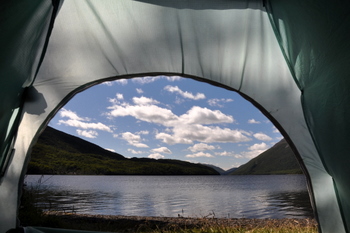
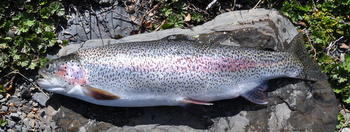
Tomorrow we return by car. It seems confirmed now. We use the last hours of the day for some repairs and cleaning of the bicycles. When the sun sets, the beaver that lives 50 meters beyond our tent begins its busy activity of carrying branches and trunks for the continuous improvement of its dwelling.
February 4, 2011: From Lago Deseado to Punta Arenas
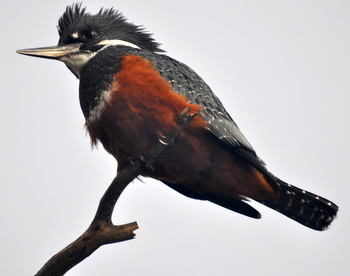
We ride to the lodge to load the bikes and say goodbye to our friends Fermín, Jorge and Nicolás. The trip is long but the conversation with Rodrigo, Andrea and Ricardo is very pleasant. During the trip, the fauna of the area keeps me awake. Guanacos are everywhere, gray foxes, cauquenes and all kinds of unknown birds, even flamingos. I would have never expected flamingos in Tierra del Fuego. Ricardo knows very well the region and he educates us about the estancias we are going through, their owners and their stories. We stop to visit the gold dredge on the riverbed. It seems like a rusty dinosaur that died in the middle of the pampa, surrounded by nothing. When we get to the junction to Porvenir, it's too late to embark on the single daily ferry. The only solution to leave the island to Punta Arenas today is to continue driving to the Primera Angostura ferry. It's 150 Km more, but that is no problem when you hover over the gravel at 100 km/h…
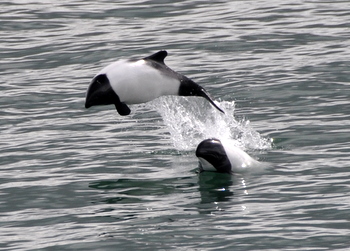
Once we arrive to Punta Arenas, we go to a very buena onda hostel, Imago Mundi. The building is an old house converted into cultural center, meeting point for artists and backpackers, all together. All the decoration consists of ancient objects recovered from the building: bottles of all colors and shapes, half rusted cutlery, tools, furniture wood, etc.
We get together with Ricardo and Andrea to have dinner at Restaurant Sotito´s Bar; a restaurant with tradition and good reputation. The local fresh fish accompanied by a bottle of carménère, an almost exclusive grape variety from Chile, is excellent. We finished the evening at their home enjoying some delicious home-grown frutilla (strawberries) ̶ nothing do with these big, perfect and tasteless strawberries you can buy at the grocery store ̶ accompanied with an excellent bottle of carménère and cabernet sauvignon of their selected cellar. Huge thanks to our friends! A perfect night to finish our stage in Tierra del Fuego.


